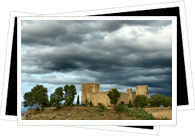
(UNESCO World Heritage City) With a history spanning over 2,000 years, it's no surprise that Toledo has quite the story to tell. From a Roman municipium to capital of the Visigoth kingdom, fortified Muslim stronghold and frontier of the Christian fight against the Moors, Toledo was born to play a leading role in Spain's history. Its UNESCO World Heritage status comes thanks to the mix of three major religions: Christianity, Judaism and Islam. In fact, Toledo is known as the "City of Three Cultures."
Back in the day, while other cities succumbed to cultural and religious inner-city strife, Toledo was unique in that the three religions managed to coexist relatively peacefully for centuries. A stunning mixture of monuments attests to those days, as the old quarter is like an open-air musuem of churches, palaces, fortresses, mosques, synagogues and much more.
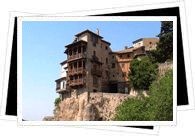
(UNESCO World Heritage City) Originally built up by Moors as a defensive stronghold in the heart of the Umayyad Caliphate of Córdoba, Cuenca is a medieval fortified city in a near immaculate state of preservation. Due to its Muslim origins, militarized nature and subsequent 12th-century Christian overtaking, the city boasts a exquisite architectural mix of Moorish homes and Christian buildings spanning numerous centuries that led to its eventual UNESCO World Heritage status. Along with its cobbled streets and preserved original townscape, Cuenca's stand-out highlights include Spain's very first Gothic cathedral as well as the famous "casas colgadas" (hanging houses), which hang precariously over the edge of sheer cliffs.
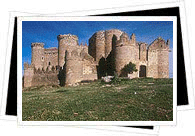
While the village is a peaceful and attractive visit in itself, Belmonte's real draw is without a doubt its 15th century castle. With a zig-zagging defensive wall, massive cylindrical towers, a peculiar triangular interior courtyard and a harmonious mix of Gothic and Mudéjar design, the stunning fortification is one of Spain's most aesthetically interesting and best-preserved castles. Plus, Spanish Golden Age literature buffs will take pleasure in visiting the castle where Don Quijote and his trusty sidekick Sancho Panza dined during one of their adventures.
One of the most recognizable - and certainly one of the most literary - symbols of Spain are the classic windmills, those monstruous giants that Don Quijote so famouly tried to battle in his picaresque delusions. Set in the sweeping, windswept plains of classic La Mancha, the attractive country villages of Campo de Criptana and Consuegra boast dozens of the best molinos (windmills) in Spain. While the windmills of Consuegra, flanking a 13th century castle, perhaps make for the most memorable sight, if you're following the Don Quijote trail, the windmills of Consuegra de Criptana are the windmills of Don Quijote fame.
If you take an extremely rewarding detour to the tranquil medieval town of Sigüenza, you'll be surprised to learn that the sleepy streets were the stage for an extremely turbulent history. Founded as a Celtiberian settlement, Sigüenza became a key Roman and later Visigothic military outpost. The arrival of the Moors in the 8th century quickly put the town right on the violent geographical and ideological border between Moors and Christians. The town later saw action as a frontline during both the War of Spanish Succession and the Spanish Civil War. The violence is long gone, however, having been replaced by quiet tranquility. Follow the twisting streets through immaculately preserved stone architecture, arched doorways, a Romanesque - Gothic cathedral and finally, at the cusp of the hill, a forbidding castle.
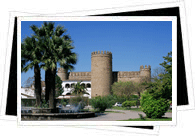
Relaxed, quiet and endlessly pretty, the beautiful old town of Zafra is every bit as picturesque and bright white as one of the famous pueblos blanco (white villages) of Andalucía. Originally a Muslim stronghold, a 15th century castle - now a parador hotel - was constructed right on top of the former Islamic alcázar (fortress). Along with cobbled alleyways, bright flowerpots and lovely white houses, churches and convents abound and the village's many arcaded plazas are lined with laid-back cafés- perfect for sitting back and soaking up the atmosphere!
A true melting pot of cultures, the blend of Roman, Islamic, Gothic and Renaissance architecture gracing the streets of Cáceres is perhaps what attracted UNESCO's World Heritage committee. An important stop along the Roman Vía de la Plata (Silver Route) and later along the religious Camino de Santiago (Way of Saint James), Cáceres' history as a focal point in the clashes between Christians and Muslims can be seen in its architecture. Aside from the mixture of Christian and Muslim architecture, Cáceres is heavily fortified; towers are dispersed throughout the historic quarter, and buildings from churches to homes are heavily fortified.
Huddled intimately on a hill overlooking the surrounding plains is the small, enticing town of Trujillo. The town's history dates back to the Romans, having later passed through the hands of Visigoths and the Muslims before the Christian Reconquest swept in and claimed the town in 1232. Within what remains of the original Muslim wall, get lost in Trujillo's intricate web of cobbled streets, terracotta-tiled houses, Renaissance mansions, leafty courtyards, fruit gardens, elegant plazas and, of course, the typical Spanish clusters of churches and convents.
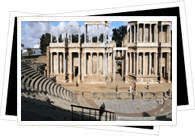
(UNESCO World Heritage City) Recognized by UNESCO's World Heritage committee as one of the best-preserved archaeological sites in Spain, Mérida was not only a major stop along the Roman Vía de la Plata (Silver Route), but was also the capital city of Lusitania back when the Roman Empire extended throughout the Iberian Peninsula. Amongst the incredible sites, check out the theater, the amphitheater, the bridge and the Temple of Diana.
Dominated by a 37 meter (121 foot) keep dating back to the 14th century, the small town of Olivenza bears many traces of its Portuguese past- in fact, it has only been Spanish since the early 19th century. Amble through the winding streets of whitewashed houses, turreted defensive walls and blue and white ceramic tiles. Be sure to complete the visit with a climb to the top of the keep - or Torre de Homenaje - for incredible panoramic views of the Extremadura countryside
Hidden in the dipping hills and valleys of the Sierra de Villuercas and huddled around the mammoth 15th century monastery of Santa María de Guadalupe, you will stumble across tiny Guadalupe. The village is a picturesque town of squat but bright whitewashed houses, bubbling fountains and ancient streets and squares of uneven cobblestones. Set in a spectacular natural landscape which ranges from lush forests of chestnut and oak trees to olive groves and vineyards, everything about the town spells charm.